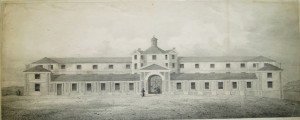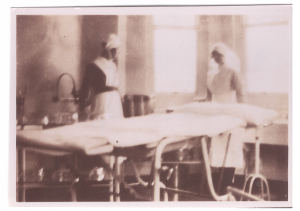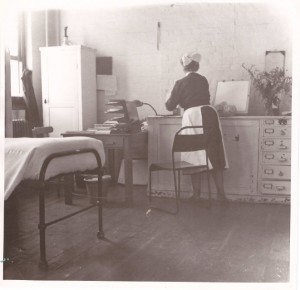
The origins of St Luke’s Hospital lie in the Guildford Poor Law Union Workhouse built in 1838. It housed 300 paupers and was run by a Workhouse Master and Matron, reporting to a local Board of Guardians. These reported, in turn, to the central government Poor Law Commissioners (later renamed Poor Law Board and then Local Government Board).
Conditions within the workhouse were grim, but sufficient to keep the pauper inmates alive. The rationale was to make life inside the Workhouse worse than that of a basic agricultural worker in the world outside. Food was basic and monotonous. In return for their keep the inmates had to perform basic labouring tasks, such as wood chopping, agriculture, laundry, cleaning, and oakum picking.
The 1838 Workhouse included a surgery and small male and female “infirmary” wards. These were most likely just basic rooms with two or three beds where sick inmates could be kept away from other inmates to prevent contagion. There were no dedicated nursing staff and it is very likely that other paupers were instructed to care for the ill, but these would be untrained, have little sympathy, and be expected to work long hours and so be of dubious help to patients. In return these ‘nurses’ were given an allowance of alcohol and consequently were often drunk.
In 1855 a Poor Law Inspector found conditions in these sick bays to be very poor. A decision was made to improve and expand the Workhouse. The works included a dedicated Workhouse Infirmary that opened in 1857. By 1891 conditions had again deteriorated. Another Poor Law Inspector found grim conditions in the Infirmary, resulting in a much larger Infirmary with 170 beds being opened in 1896. It is not known when dedicated nurses began to be employed.
Little changed until World War 1 when the hospital was removed from Guardian’s control in 1915 and used as a Military Hospital, being returned to civilian use in 1920. Sometime in the 1920s it was renamed Warren Road Infirmary.

Throughout the 1920s more of the building was gradually converted to infirmary use. In 1930 management of the Infirmary transferred to Surrey County Council and it was renamed Warren Road Hospital. By 1937 the Infirmary had 254 beds.
For the Second World War the Hospital, along with the Royal Surrey County Hospital, become part of London’s Emergency Medical Services. It formed part of Sector 11 (South West London) led by St. Thomas’ Hospital, London. Canadian Soldiers erected many ‘temporary’ huts to house both additional patients and additional facilities – including the Sector’s Radiotherapy Department, relocated from St Thomas’ to free Central London resources for civilian casualties. Guildford staff were supplemented by doctors and nurses from St Thomas’ and St George’s, Battersea.

In 1945 it was renamed St Luke’s Hospital and on transfer to the National Health Service in 1948, had 425 beds. After the war St Luke’s and the Royal Surrey County Hospitals continued to work closely together, formalised in a ‘clinical union’ in 1952. Many of the Group’s specialist facilities were located at St Luke’s including Maternity/Midwifery and Gynaecology, McMillan Day Hospital, the Nursing School, Radiotherapy Department, and Pathology Laboratories/Public Health Services.
At its peak in 1986 St Luke’s had a total of 500+ in-patient and day-case beds. Patient/acute services were gradually transferred to the new Royal Surrey County Hospital at Egerton Road . However, nurse training was considerably expanded at St Luke’s in 1990.
Services continued to transfer to Egerton Road with the last patient leaving St Luke’s on 6th November 1996.